The neurophysiological effects of single-dose theophylline in patients with chronic stroke: A double-blind, placebo-controlled, randomized cross-over study
- PMID: 27567756
- PMCID: PMC5333922
- DOI: 10.3233/RNN-160657
The neurophysiological effects of single-dose theophylline in patients with chronic stroke: A double-blind, placebo-controlled, randomized cross-over study
Abstract
Background: Reducing inhibitory neurotransmission with pharmacological agents is a potential approach for augmenting plasticity after stroke. Previous work in healthy subjects showed diminished intracortical inhibition after administration of theophylline.
Objective: We assessed the effect of single-dose theophylline on intracortical and interhemispheric inhibition in patients with chronic stroke, in a double-blind, placebo-controlled, cross-over study.
Methods: Eighteen subjects were randomly administered 300 mg of extended-release theophylline or placebo. Immediately and 5 hours following administration, transcranial magnetic stimulation was used to assess bihemispheric resting motor threshold, short-interval intracortical inhibition, long-interval intracortical inhibition, and interhemispheric inhibition. Adverse effects on cardiovascular, neurological, and motor performance outcomes were also surveilled. Change between morning and afternoon sessions were compared across conditions. One week later, patients underwent the same assessments after crossing over to the opposite experimental condition. Subjects and investigators were blinded to the experimental condition during data acquisition and analysis.
Results: For both hemispheres, changes in intracortical or interhemispheric neurophysiology were comparable under theophylline and placebo conditions. Theophylline induced no adverse neurological, cardiovascular, or motor performance effects. For both conditions and hemipsheres, the baseline level of inhibition inversely correlated with its change between sessions: less baseline inhibition (i.e. disinhibition) was associated with a strengthening in inhibition over the day, and vice versa.
Conclusion: A single dose of theophylline is well-tolerated by patients with chronic stroke, but does not alter cortical excitability. The inverse relationship between baseline inhibition and its change suggests the existence of a homeostatic process. The lack of effect on cortical inhibition may be related to an insufficiently long exposure to theophylline, or to differential responsiveness of disinhibited neural circuitry in patients with stroke.
Keywords: Recovery of function; cerebral infarction; homeostasis; motor cortex; transcranial magnetic stimulation.
Figures
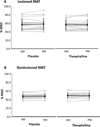
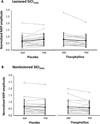
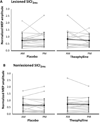
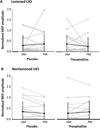
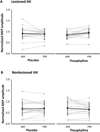


Similar articles
-
Changes in thresholds for intracortical excitability in chronic stroke: more than just altered intracortical inhibition.Restor Neurol Neurosci. 2013;31(6):693-705. doi: 10.3233/RNN-120300. Restor Neurol Neurosci. 2013. PMID: 23963339
-
The effects of combined repetitive transcranial magnetic stimulation and transcranial direct current stimulation on motor function in patients with stroke.Restor Neurol Neurosci. 2016 Nov 22;34(6):915-923. doi: 10.3233/RNN-160654. Restor Neurol Neurosci. 2016. PMID: 27689549 Clinical Trial.
-
Induction of cortical plasticity and improved motor performance following unilateral and bilateral transcranial direct current stimulation of the primary motor cortex.BMC Neurosci. 2013 Jul 1;14:64. doi: 10.1186/1471-2202-14-64. BMC Neurosci. 2013. PMID: 23815634 Free PMC article. Clinical Trial.
-
Longitudinal changes of motor cortical excitability and transcallosal inhibition after subcortical stroke.Clin Neurophysiol. 2014 Oct;125(10):2055-69. doi: 10.1016/j.clinph.2014.01.034. Epub 2014 Feb 28. Clin Neurophysiol. 2014. PMID: 24636830
-
Interhemispheric asymmetries of motor cortex excitability in the postacute stroke stage: a paired-pulse transcranial magnetic stimulation study.Stroke. 2003 Nov;34(11):2653-8. doi: 10.1161/01.STR.0000092122.96722.72. Epub 2003 Oct 9. Stroke. 2003. PMID: 14551397 Clinical Trial.
Cited by
-
Effect of paired-pulse stimulus parameters on the two phases of short interval intracortical inhibition in the quadriceps muscle group.Restor Neurol Neurosci. 2019;37(4):363-374. doi: 10.3233/RNN-180894. Restor Neurol Neurosci. 2019. PMID: 31306142 Free PMC article.
-
A Systematic Review of Long-Interval Intracortical Inhibition as a Biomarker in Neuropsychiatric Disorders.Front Psychiatry. 2021 Jun 2;12:678088. doi: 10.3389/fpsyt.2021.678088. eCollection 2021. Front Psychiatry. 2021. PMID: 34149483 Free PMC article.
References
-
- American Lung Association. Clinical trial of low-dose theophylline and montelukast in patients with poorly controlled asthma. American Journal of Respiratory and Critical Care Medicine. 2007;175(3):235–242. - PubMed
-
- Beckerman H, Roebroeck ME, Lankhorst GJ, Becher JG, Bezemer PD, Verbeek AL. Smallest real difference, a link between reproducibility and responsiveness. Quality of Life Research. 2001;10(7):571–578. - PubMed
Publication types
MeSH terms
Substances
Grants and funding
LinkOut - more resources
Full Text Sources
Other Literature Sources
Medical

